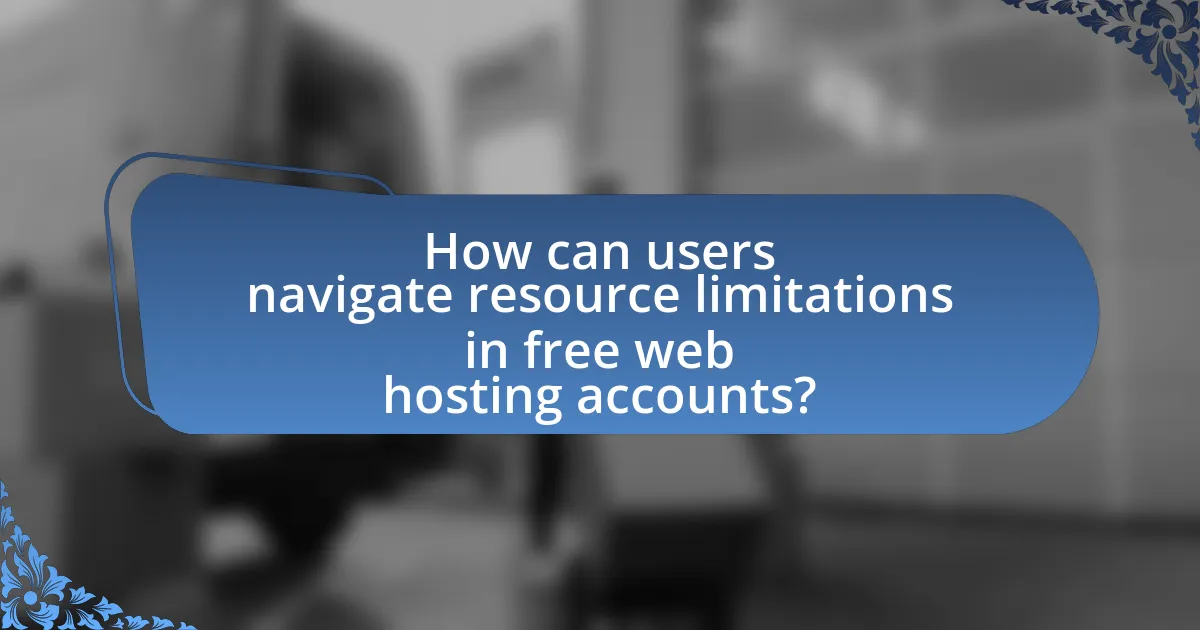Resource limitations in free web hosting accounts encompass constraints on storage space, bandwidth, CPU usage, and database access, which are essential for managing server load and ensuring fair usage among users. These limitations can significantly impact website performance, leading to slower load times, increased latency, and potential downtime, ultimately affecting user experience and engagement. Common restrictions include capped storage and bandwidth, reduced processing power, and limited customer support, which can hinder a website’s growth and functionality. Free hosting providers impose these limitations to manage costs and maintain service quality, often operating under advertising-based or freemium business models. Users must navigate these constraints carefully, employing optimization strategies and considering upgrades to paid hosting solutions when necessary.

What are Resource Limitations in Free Web Hosting Accounts?
Resource limitations in free web hosting accounts refer to the constraints placed on various resources such as storage space, bandwidth, CPU usage, and database access. These limitations are implemented to manage server load and ensure fair usage among users. For instance, many free hosting services offer limited storage, often ranging from 500 MB to 2 GB, and bandwidth caps that can restrict data transfer to a few gigabytes per month. Additionally, CPU usage may be throttled to prevent any single account from monopolizing server resources, which can lead to slower performance or downtime. These constraints are essential for maintaining the overall stability and performance of shared hosting environments.
How do resource limitations impact website performance?
Resource limitations significantly degrade website performance by restricting the availability of essential computing resources such as CPU, memory, and bandwidth. When a website operates under constrained resources, it experiences slower load times, increased latency, and potential downtime, which can lead to a poor user experience. For instance, a study by Google found that a one-second delay in mobile page load time can reduce conversions by up to 20%. Additionally, limited bandwidth can cause bottlenecks during high traffic periods, resulting in timeouts or errors. These performance issues directly affect user engagement and retention, ultimately impacting the website’s effectiveness and success.
What specific resources are typically limited in free web hosting accounts?
Free web hosting accounts typically limit resources such as storage space, bandwidth, and server performance. For instance, storage space may be capped at a few hundred megabytes, while bandwidth could be restricted to a certain number of monthly data transfers, often around 1-5 GB. Additionally, server performance may be throttled, resulting in slower loading times and limited processing power. These limitations are implemented to manage costs and encourage users to upgrade to paid hosting plans, which offer more robust resources and capabilities.
How do these limitations affect user experience?
Resource limitations in free web hosting accounts significantly degrade user experience by causing slow loading times and frequent downtime. Users often encounter delays when accessing websites, as limited bandwidth restricts data transfer speeds. Additionally, inadequate server resources can lead to crashes or unavailability during peak traffic, frustrating users and potentially driving them away. Research indicates that a one-second delay in page load time can result in a 7% reduction in conversions, highlighting the critical impact of these limitations on user satisfaction and engagement.
Why do free web hosting providers impose resource limitations?
Free web hosting providers impose resource limitations to manage server load and ensure fair usage among users. These providers typically offer services at no cost, which leads to a high number of users sharing limited resources such as bandwidth, storage, and processing power. By imposing restrictions, they can prevent any single user from monopolizing resources, which could degrade performance for others. Additionally, resource limitations help free hosting providers control operational costs and maintain service quality, as unlimited resources would require significant financial investment in infrastructure and maintenance.
What are the business models behind free web hosting services?
Free web hosting services primarily operate on advertising-based and freemium business models. In the advertising-based model, providers offer free hosting in exchange for displaying ads on users’ websites, generating revenue through ad impressions and clicks. For instance, companies like WordPress.com and Wix utilize this approach, allowing users to create websites at no cost while monetizing through advertisements.
In the freemium model, basic hosting services are provided for free, but users are encouraged to upgrade to paid plans for additional features, resources, or support. This model is exemplified by platforms like Weebly and InfinityFree, where users can access essential services without charge but must pay for enhanced capabilities, such as increased storage or custom domain names.
These business models enable free web hosting services to sustain operations while attracting a large user base, which can later be converted into paying customers.
How do resource limitations help providers manage costs?
Resource limitations help providers manage costs by controlling the amount of resources allocated to each user, thereby preventing overuse and ensuring sustainability. By imposing limits on bandwidth, storage, and processing power, providers can maintain a balanced load on their servers, which reduces operational expenses and minimizes the risk of service degradation. For instance, a study by the International Journal of Information Management highlights that resource allocation strategies in cloud services can lead to a 30% reduction in operational costs by optimizing resource utilization. This structured approach allows providers to offer free hosting services while maintaining profitability through efficient resource management.
What are the common types of resource limitations in free web hosting?
Common types of resource limitations in free web hosting include restricted bandwidth, limited storage space, and reduced processing power. Bandwidth limitations often cap the amount of data that can be transferred to and from the website, which can hinder performance during high traffic periods. Limited storage space restricts the amount of content that can be uploaded, affecting the website’s scalability. Reduced processing power can lead to slower loading times and limited functionality, as free hosting services typically allocate fewer server resources compared to paid options. These constraints are designed to manage costs and ensure fair usage among users.
What is bandwidth limitation and how does it affect users?
Bandwidth limitation refers to the maximum rate of data transfer that a network can handle, which directly impacts users by restricting the amount of data they can upload or download within a specific timeframe. When bandwidth is limited, users may experience slower internet speeds, increased latency, and interruptions in service, particularly during peak usage times. For instance, if a free web hosting account has a bandwidth cap of 1 GB per month, users may find their websites slow to load or even inaccessible once they exceed this limit, leading to potential loss of visitors and reduced functionality. This limitation is particularly significant for users relying on their websites for business or critical services, as it can hinder performance and user experience.
How does storage space limitation impact website functionality?
Storage space limitation directly impacts website functionality by restricting the amount of data that can be stored and served to users. When a website exceeds its allocated storage, it may experience issues such as slow loading times, inability to upload new content, or even complete downtime. For instance, a study by the HostingAdvice team found that websites with limited storage often face performance degradation, leading to higher bounce rates and lower user engagement. This limitation can hinder a website’s ability to grow and adapt, ultimately affecting its overall effectiveness and user experience.
What are the implications of CPU and memory usage restrictions?
CPU and memory usage restrictions in free web hosting accounts can lead to performance bottlenecks and limited scalability. These restrictions often result in slower response times for applications, as the server may struggle to handle multiple requests simultaneously. Additionally, users may experience downtime or service interruptions when resource limits are exceeded, impacting the reliability of hosted websites. Studies indicate that websites with constrained resources can face increased latency, which negatively affects user experience and search engine rankings. Therefore, understanding these implications is crucial for users relying on free hosting services.

How can users navigate resource limitations in free web hosting accounts?
Users can navigate resource limitations in free web hosting accounts by optimizing their website’s performance and resource usage. This can be achieved through techniques such as minimizing file sizes, using efficient coding practices, and leveraging caching mechanisms to reduce server load. For instance, compressing images and utilizing content delivery networks (CDNs) can significantly decrease bandwidth consumption. Additionally, users should monitor their resource usage regularly to identify bottlenecks and adjust their strategies accordingly. Research indicates that websites optimized for performance can load up to 50% faster, which directly correlates with reduced resource consumption and improved user experience.
What strategies can users employ to optimize their resource usage?
Users can optimize their resource usage by implementing strategies such as efficient coding practices, utilizing caching mechanisms, and monitoring resource consumption. Efficient coding practices, such as minimizing file sizes and reducing server requests, can significantly lower resource usage. For instance, using minified CSS and JavaScript files can reduce load times and server strain. Caching mechanisms, like browser caching and server-side caching, can store frequently accessed data, reducing the need for repeated resource requests. Monitoring tools, such as Google Analytics or server logs, allow users to track resource consumption patterns, enabling them to identify and address inefficiencies. These strategies collectively help users maximize the performance of their free web hosting accounts while staying within resource limitations.
How can website design influence resource consumption?
Website design significantly influences resource consumption by determining the efficiency of code, the size of assets, and the overall user experience. Efficient website design minimizes the use of heavy images, scripts, and unnecessary plugins, which directly reduces bandwidth and server load. For instance, a study by Google found that reducing page load time by just one second can lead to a 20% increase in page views, indicating that faster, well-optimized designs consume fewer resources. Additionally, responsive design practices ensure that websites adapt to various devices, optimizing resource use across different screen sizes. Therefore, thoughtful website design not only enhances user experience but also plays a crucial role in managing resource consumption effectively.
What tools can help monitor resource usage effectively?
Tools that can help monitor resource usage effectively include Google Analytics, New Relic, and Datadog. Google Analytics provides insights into website traffic and user behavior, allowing users to track resource consumption related to web hosting. New Relic offers application performance monitoring, enabling users to analyze server response times and resource allocation. Datadog integrates with various services to provide real-time monitoring of cloud infrastructure, helping users understand resource utilization across their hosting environment. These tools are widely recognized for their effectiveness in tracking and optimizing resource usage in web hosting scenarios.
When should users consider upgrading from free hosting?
Users should consider upgrading from free hosting when they experience limitations in bandwidth, storage, or support that hinder their website’s performance or growth. Free hosting often imposes strict resource caps, which can lead to slow loading times, frequent downtime, and lack of customer support. For instance, if a website receives increased traffic and exceeds the allocated bandwidth, it may become inaccessible, directly impacting user experience and potential revenue. Additionally, free hosting typically lacks essential features such as custom domain names and advanced security measures, which are crucial for professional online presence. Therefore, when users encounter these limitations, it is advisable to upgrade to a paid hosting plan that offers greater resources and support.
What signs indicate that a website has outgrown free hosting limitations?
A website has outgrown free hosting limitations when it experiences frequent downtime, slow loading speeds, and limited storage or bandwidth. These signs indicate that the resources provided by free hosting are insufficient for the website’s needs. For instance, if a website is consistently unavailable or takes too long to load, it can lead to a poor user experience and decreased traffic. Additionally, if the website exceeds the storage or bandwidth limits set by the free hosting provider, it may face restrictions or additional charges, further confirming that it has outgrown the limitations of free hosting.
How can users evaluate the cost-benefit of upgrading to paid hosting?
Users can evaluate the cost-benefit of upgrading to paid hosting by comparing the features and performance of free hosting against the requirements of their website. Key factors to consider include bandwidth, storage capacity, uptime guarantees, customer support, and scalability options. For instance, free hosting often limits bandwidth and storage, which can lead to slow loading times and downtime, negatively impacting user experience and SEO rankings. In contrast, paid hosting typically offers higher bandwidth and storage, ensuring better performance and reliability. According to a study by HostingAdvice, websites on paid hosting experience 99.9% uptime compared to an average of 95% for free hosting. This data supports the notion that investing in paid hosting can lead to improved website performance and user satisfaction, ultimately justifying the cost.

What are the potential risks of using free web hosting accounts?
Using free web hosting accounts poses several potential risks, including limited resources, lack of customer support, and security vulnerabilities. Limited resources can lead to slow website performance and downtime, as free hosting often comes with bandwidth and storage restrictions. The absence of reliable customer support can hinder problem resolution, leaving users without assistance during critical issues. Additionally, free hosting services may not implement robust security measures, increasing the risk of data breaches and malware attacks. According to a 2021 study by the Cybersecurity & Infrastructure Security Agency, websites hosted on free platforms are 50% more likely to experience security incidents compared to those on paid services.
How do resource limitations affect website security?
Resource limitations significantly compromise website security by restricting the ability to implement robust security measures. When a website operates under constrained resources, such as limited bandwidth, storage, and processing power, it often lacks the capacity to deploy advanced security protocols like firewalls, intrusion detection systems, and regular software updates. For instance, a study by the Ponemon Institute found that organizations with inadequate resources are 50% more likely to experience a data breach. This vulnerability arises because resource limitations hinder timely responses to security threats and reduce the overall resilience of the website against attacks.
What vulnerabilities are associated with free web hosting services?
Free web hosting services are associated with several vulnerabilities, including limited security measures, lack of customer support, and potential data loss. These services often do not provide robust security protocols, making websites susceptible to hacking and malware attacks. Additionally, the absence of reliable customer support can hinder timely resolution of issues, leaving users vulnerable to prolonged downtime or data breaches. Furthermore, free hosting platforms may impose restrictions on data backups, increasing the risk of data loss in case of server failures or other technical problems.
How can users protect their websites from security threats?
Users can protect their websites from security threats by implementing strong security measures such as using HTTPS, regularly updating software, and employing firewalls. HTTPS encrypts data transmitted between the user and the website, reducing the risk of interception. Regular software updates patch vulnerabilities that could be exploited by attackers, while firewalls monitor and control incoming and outgoing network traffic based on predetermined security rules. According to a report by the Cybersecurity & Infrastructure Security Agency, 85% of successful cyberattacks exploit known vulnerabilities, highlighting the importance of these protective measures.
What are the long-term implications of relying on free web hosting?
Relying on free web hosting can lead to significant long-term implications, including limited resources, lack of control, and potential security risks. Users often face restrictions on bandwidth, storage, and features, which can hinder website performance and scalability as traffic grows. Additionally, free hosting services typically offer minimal customer support and may impose advertisements on users’ sites, affecting professionalism and user experience. Security vulnerabilities are also a concern, as free hosting providers may not implement robust security measures, increasing the risk of data breaches. These factors can ultimately impact a website’s credibility, user retention, and overall success in the long run.
How can resource limitations hinder business growth?
Resource limitations can significantly hinder business growth by restricting operational capabilities and scalability. For instance, inadequate server resources in free web hosting accounts can lead to slow website performance, resulting in poor user experience and decreased customer retention. According to a study by Google, 53% of mobile site visits are abandoned if a page takes longer than three seconds to load, illustrating the direct impact of resource constraints on user engagement and potential revenue. Additionally, limited bandwidth can restrict the ability to handle increased traffic, which is crucial for growth during peak times or marketing campaigns. This lack of scalability can prevent businesses from capitalizing on opportunities, ultimately stunting their growth trajectory.
What alternatives exist for users seeking more reliable hosting solutions?
Users seeking more reliable hosting solutions can consider options such as paid shared hosting, virtual private servers (VPS), dedicated servers, and cloud hosting. Paid shared hosting offers improved reliability and support compared to free options, while VPS provides dedicated resources and greater control. Dedicated servers offer maximum performance and security for high-traffic websites, and cloud hosting ensures scalability and redundancy, minimizing downtime. According to a 2021 study by HostingAdvice, 70% of users reported better uptime and support with paid hosting services compared to free hosting.
What best practices should users follow when using free web hosting accounts?
Users should prioritize understanding the limitations of free web hosting accounts to optimize their experience. This includes recognizing bandwidth and storage restrictions, which often lead to slower performance and potential downtime. Users should also regularly back up their data, as free services may not provide reliable backup solutions. Additionally, users should avoid using free hosting for critical business applications due to the lack of customer support and security features. Lastly, users should consider upgrading to paid plans if their needs exceed the limitations of free hosting, as this can enhance performance and reliability.
How can users effectively manage their expectations with free hosting?
Users can effectively manage their expectations with free hosting by understanding the inherent limitations and trade-offs associated with such services. Free hosting often comes with restricted bandwidth, limited storage space, and fewer features compared to paid options, which can impact website performance and reliability. For instance, many free hosting providers impose data transfer limits that can lead to slow loading times or downtime during peak traffic periods. Additionally, users should be aware that free hosting may include advertisements or branding from the provider, which can detract from the user experience. Recognizing these factors allows users to set realistic goals for their website’s performance and functionality, ensuring they do not expect the same level of service as paid hosting solutions.
What common pitfalls should users avoid when selecting a free hosting provider?
Users should avoid several common pitfalls when selecting a free hosting provider, including inadequate resource allocation, lack of customer support, and hidden fees. Inadequate resource allocation can lead to slow website performance and downtime, as many free hosting services impose strict limits on bandwidth and storage. Lack of customer support can leave users stranded during critical issues, as many free providers offer minimal or no assistance. Hidden fees may arise when users attempt to upgrade services or remove ads, which can lead to unexpected costs. These pitfalls can significantly impact the functionality and reliability of a website hosted on a free platform.


